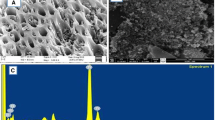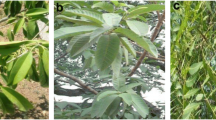Abstract
Due to the increasing population, the production of food and boosting its productivity is the major challenge around the globe. Nanotechnology is a crucial modern science that has brilliant applications in all sciences including agriculture sectors. Nano-particles have a considerable impact on the growth, the germination rate of the plants. Silver (AgNPs), Titanium dioxide nanoparticles (TiO2 NPs) and their composites (Ag–TiO2 NCs) in powdered form have been synthesized by chemical reduction method and precipitation method using silver nitrate (AgNO3), titanium tetra-butoxide (TBT), sodium boro-hydride with acetic acid. The morphological and structural properties of synthesized nanoparticles and nanocomposites were studied by UV–visible spectroscopy, Energy Dispersive X-Ray spectroscopy (EDX), Scanning Electron Microscopy (SEM) and X-Ray Powder Diffraction (XRD). The Energy bandgap for AgNPs was 2.8, 3.56, and 3.18 eV for TiO2 and Ag–TiO2 NCs, respectively, as analyzed by UV–visible spectroscopy. The peaks in the EDX spectrum confirmed the composition of material formation and purity of AgNPs, TiO2 NPs, and Ag–TiO2 NCs. Seeds of soybean and wheat were sowed in Petri dishes in the suspension of AgNPs, TiO2 NPs, and Ag–TiO2 NCs separately with various concentrations of NPs. The effect of various concentrations of metallic NPs and NCs on the different parameters of germination has been studied. This study revealed that applications of metallic NPs and NCs can help to enhance the germination, root and shoot length and mean germination time as compared to control treatment. It was found that suitable small-time soaking favors a high germination rate. Furthermore, a lesser concentration of AgNPs, Ag–NCs significantly increases germinability, suppress germination rate, elongates root and shoot length and reduce mean germination time.














Similar content being viewed by others
References
Afsheen S et al (2020) Synthesis and characterization of metal sulphide nanoparticles to investigate the effect of nanoparticles on germination of soybean and wheat seeds. Mater Chem Phys 252:123216
Almalah HI, Alzahrani HA, Abdelkader HS (2019) Green synthesis of silver nanoparticles using cinnamomum zylinicum and their synergistic effect against multi-drug resistance bacteria. J Nanotechnol Res 1(3):95–107
Almutairi ZM, Alharbi A (2015) Effect of silver nanoparticles on seed germination of crop plants. J Adv Agric 4(1):283–288
Cheng H et al (1995) Hydrothermal preparation of uniform nanosize rutile and anatase particles. Chem Mater 7(4):663–671
Cho K-H et al (2005) The study of antimicrobial activity and preservative effects of nanosilver ingredient. Electrochim Acta 51(5):956–960
Chowdhury S et al (2017) The aggregation study and characterization of silver nanoparticles. Solid State Phenom 263:165–169
Durán N et al (2007) Antibacterial effect of silver nanoparticles produced by fungal process on textile fabrics and their effluent treatment. J Biomed Nanotechnol 3(2):203–208
Fan S et al (2016) A rapid method to determine germinability and viability of Agriophyllum squarrosum (Amaranthaceae) seeds. Seed Sci Technol 44(2):410–415
Feng Y et al (2015) Can Tauc plot extrapolation be used for direct-band-gap semiconductor nanocrystals? J Appl Phys 117(12):125701
Haider AJ, Jameel ZN, Taha SY (2015) Synthesis and characterization of TiO2 nanoparticles via sol-gel method by pulse laser ablation. Eng Technol J 33(5 Part (B) Scientific):761–771
Hamouda RA et al (2019) Synthesis and biological characterization of silver nanoparticles derived from the cyanobacterium Oscillatoria limnetica. Sci Rep 9(1):1–17
Hariharan D, Srinivasan K, Nehru L (2017) Synthesis and characterization of TiO2 nanoparticles using cynodon dactylon leaf extract for antibacterial and anticancer (A549 cell lines) activity. J Nanomed Res 5(6):138–142
Ijaz M et al (2020a) A review on Ag-nanostructures for enhancement in shelf time of fruits. J Inorg Organomet Polym Mater 30(5):1475–1482
Ijaz M et al (2020b) A review on antibacterial properties of biologically synthesized zinc oxide nanostructures. J Inorg Organomet Polym Mater 30:2815–2826
Ijaz M, Zafar M (2021) Titanium dioxide nanostructures as efficient photocatalyst: progress, challenges and perspective. Int J Energy Res 45(3):3569–3589
Ijaz M, Zafar M, Iqbal T (2021) Green synthesis of silver nanoparticles by using various extracts: a review. Inorg Nano-Met Chem 51(5):744–755
Ikezawa S et al (2001) Applications of TiO2 film for environmental purification deposited by controlled electron beam-excited plasma. Thin Solid Films 386(2):173–176
Jiang H et al (2004) Plasma-enhanced deposition of silver nanoparticles onto polymer and metal surfaces for the generation of antimicrobial characteristics. J Appl Polym Sci 93(3):1411–1422
Kalemba EM, Ratajczak E (2018) The effect of a doubled glutathione level on parameters affecting the germinability of recalcitrant Acer saccharinum seeds during drying. J Plant Physiol 223:72–83
Karimi N et al (2012) Application of silver nano-particles for protection of seeds in different soils. Afr J Agric Res 7(12):1863–1869
Klaus-Joerger T et al (2001) Bacteria as workers in the living factory: metal-accumulating bacteria and their potential for materials science. Trends Biotechnol 19(1):15–20
Kumar N et al (2021) Structural and optical properties of sol–gel derived CuO and Cu2O nanoparticles. Mater Today Proc 41(2):237–241
Lin D, Xing B (2007) Phytotoxicity of nanoparticles: inhibition of seed germination and root growth. Environ Pollut 150(2):243–250
Mahshid S, Askari M, Ghamsari MS (2007) Synthesis of TiO2 nanoparticles by hydrolysis and peptization of titanium isopropoxide solution. J Mater Process Technol 189(1–3):296–300
Mattiello A, Marchiol L (2017) Application of nanotechnology in agriculture: assessment of TiO2 nanoparticle effects on barley. In: Janus M (ed) Application of titanium dioxide. InTech, London, pp 23–39
Mousavi SR, Rezaei M (2011) Nanotechnology in agriculture and food production. J Appl Environ Biol Sci 1(10):414–419
Mukhopadhyay SS (2014) Nanotechnology in agriculture: prospects and constraints. Nanotechnol Sci Appl 7:63
Nguyen HC et al (2016) Preparation of Ag/SiO2 nanocomposite and assessment of its antifungal effect on soybean plant (a Vietnamese species DT-26). Adv Nat Sci Nanosci Nanotechnol 7(4):045014
Okpala CC (2014) The benefits and applications of nanocomposites. Int J Adv Eng Tech 12:18
Prasanna B, Hossain F (2007) Nanotechnology in agriculture. ICAR National Fellow, Division of Genetics, IARI, New Delhi
Rawat M et al (2017) Physio-biochemical basis of iron-sulfide nanoparticle induced growth and seed yield enhancement in B. juncea. Plant Physiol Biochem 118:274–284
Sardabi F et al (2014) The effects of 1-methylcyclopropen (1-MCP) and potassium permanganate coated zeolite nanoparticles on shelf life extension and quality loss of golden delicious apples. J Food Process Preserv 38(6):2176–2182
Savithramma N, Ankanna S, Bhumi G (2012) Effect of nanoparticles on seed germination and seedling growth of Boswellia ovalifoliolata an endemic and endangered medicinal tree taxon. Nano Vis 2(1):2
Shahjahan M et al (2017) Synthesis and characterization of silver nanoparticles by sol-gel technique. Nanosci Nanometrol 3(1):34–39
Zhang X-F et al (2016) Silver nanoparticles: synthesis, characterization, properties, applications, and therapeutic approaches. Int J Mol Sci 17(9):1534
Zoccal JVM, Arouca FO, Gonçalves JAS (2010) Synthesis and characterization of TiO2 nanoparticles by the method pechini. Mater Sci Forum 660–661:385–390
Author information
Authors and Affiliations
Contributions
Tahir Iqbal: Funding acquisition, conceptualization, and supervision. Fariha Iran: writing—original draft. Sumera Afsheen: conceptualization and formal analysis. Maria Zafar: data curation. Sumera Usman: validation. Ahmed Raza: project administration.
Corresponding authors
Ethics declarations
Conflict of interest
On behalf of all authors, the corresponding author states that there is no conflict of interest.
Additional information
Publisher's Note
Springer Nature remains neutral with regard to jurisdictional claims in published maps and institutional affiliations.
Rights and permissions
About this article
Cite this article
Iqbal, T., Irfan, F., Afsheen, S. et al. Synthesis and characterization of Ag–TiO2 nano-composites to study their effect on seed germination. Appl Nanosci 11, 2043–2057 (2021). https://doi.org/10.1007/s13204-021-01912-6
Received:
Accepted:
Published:
Issue Date:
DOI: https://doi.org/10.1007/s13204-021-01912-6




